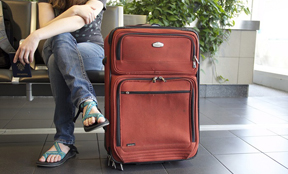
The European Entry/Exit System - or EES as it is known - is a digital system that will track arrivals and departures of non-EU visitors to the Schengen area. It is designed to spot travellers using fake passports while also keeping track of those who are not entitled to enter the EU or who stay for too long.
Here is all the information you need about the new system for British travellers heading to the EU.
 Find out about the new EES
needed to enter the EU. (Credit: Pexels)
Find out about the new EES
needed to enter the EU. (Credit: Pexels)
EES start date confirmed
What data will the EES take from me and how long will it be kept?
The EES will require scans of fingerprints and a photo of the traveller when they first entry into the EU. Passports will also be scanned to log the holder's movements, and their identity will be checked against a security list. These records will be kept for three years, unless no exit date is recorded, in which case they will be kept for five years.
Can I avoid the EES – are there exemptions?
Non-EU nationals who have official residency in an EU country will be exempt from the EES. Additionally, EU family members are not subject to the 90-day rule if they stay with their EU partner beyond this time limit.
What happens if I refuse to have my fingerprints scanned or my face photographed?
If a non-EU national travelling for a short stay refuses to provide biometric data - such as fingerprints and a photo of their face - they will be denied entry into European countries using EES.
Will the new EES mean delays for my holiday at EU airports, Port of Dover and Eurotunnel at Folkestone?
The EU claims the EES will eventually save time at borders, but there concerns the new system will, initially at least, cause long queues at airport and ferry ports. As soon as more passengers are in the system, it is hoped that these queues will start to ease.
UK authorities fear that the EES system could impact travellers at the Port of Dover and Eurotunnel services at Folkestone particularly hard. French authorities will be able to operate at both of these UK borders due t a reciprocal agreement. Ferry and train operators have stated their concerns that there could be long delays at these checkpoints.
The UK government has said it is talking to local operators and the French authorities to find ways to minimise the delays, but travellers are likely to experience problems with hold-ups when the EES initially comes into force sometime in 2023.
The European Commission has said it "may be necessary to allow for some degree of flexibility — when strictly necessary — to avoid long waiting times at specific border crossing points".
Which European countries will use the EES?
Countries that will use the EES include Austria, Belgium, Croatia, Denmark, France, Greece, Iceland, Italy, Liechtenstein, Malta, Portugal, Spain, and Switzerland. Cyprus and Ireland are EU countries but are not in the Schengen area and will continue to stamp passports manually.
Can I view EES documents and check my day limit?
Yes. Once the system is operational, travellers in the system will be able to receive information on their stay from passport control officers. There will also be an online tool to let traveller check their records time limits on their stay within the EU.
What happens if people overstay?
If someone overstays, their data will be added to an overstayer list, and they risk fines or other sanctions.
When will the EES start?
The the official plan was for the system to start in 2022, but this was delayed to May 2023, before a further delay has seen the start date pushed back to October 12, 2025. There will be a 'phasing in period' of six months for it to be fully operated at all customs points.
What is the difference between EES and Etias?
The EES (European Entry-Exit System) is a border management system that will track the entry and exit of non-EU citizens in the Schengen area. The EES will not require any prior authorisation, but will instead be used to ensure compliance with visa and migration rules.
What is Etias?
Etias (European Travel Information and Authorisation System) is an online visa-waiver pre-approval system for non-EU citizens who wish to visit the EU. This system will become mandatory starting from November of this year.
Who will need an Etias?
All non-EU citizens will need an Etias to visit the EU, including children. The adult parent or guardian will need to apply for the Etias on behalf of the minor.
What information is required for an Etias application?
The Etias application will be considered quite intrusive y many travellers - requiring them to provide information including name, address, and contact details, passport details, educational level, occupation, and the first intended address in the EU.
It will also ask for information regarding any criminal convictions, travel to war zones, and previous orders to leave an EU country.
How much does an Etias cost?
The Etias will cost €7 for adults aged 18 to 70 and will be valid for three years or until the person's passport expires. Kids will not be charged for the Etias.
When should I apply for an Etias?
People are advised to apply for an Etias before booking travel and accommodation in case of delays in approval. The application process may take from a few minutes to 4 days, and in some cases, further information or an interview may be required, which could take up to an additional 30 days.
Some sections of this article were created with AI. Please check the latest official information before travelling.
Most read travel content
Take a look at more of our top travel-related news and guides here...
-
Do I need six or three months on my passport for Spain, France and other EU countries?
-
Who can sign my passport photo... can teaching assistants sign for kids?
-
Can I carry medication on a plane - what the airlines and airports say
-
How do UK airlines keep their planes germ-free?
-
How much are fast-track security lanes at UK airports and how to book them
-
Where do I pack my vape when flying? What the airlines say
-
Can my child fly if they have chicken pox? What the airlines say
-
Can I catch monkeypox on a plane - what are the risks?
-
Full list of European countries that use the euro - and those that don't
-
What does SSSS on your boarding card mean and should you be worried?
-
Do I need a V103 certificate to drive my car abroad?
-
Do I need a new passport now I have put on weight, dyed hair, gone bald etc?
-
Get a driving licence check code for your holiday hire car
-
Find the cheapest petrol near motorways in France - interactive map
-
Are there any free drop-off points at UK airports?
-
How much does a new passport cost now we've left the EU?
-
How much are speeding fines and other driving offences in Spain? And will points go on my UK licence?
-
Can I change a name on a plane ticket and how much will it be?
-
The new speeding camera in France that 'catches everyone' - Nano Parifex revealed
-
Can I fly with a broken leg or other bone?
-
Is it possible to catch monkey pox on a plane?
-
How much are extra legroom seats on your flight - revealed here
-
Where can I charge an electric car at UK airports?
-
What airlines have defibrillators on their planes
-
What help is there for travellers with autism at UK airports?
-
Do I need to get a new passport if I move home?
Subscribe for free motoring and travel news
Author: Pete Barden:
Twitter: @pete_barden
Pete Barden is a qualified journalist who has written and produced for publications including The Sun (thesun.co.uk), New Statesman Media Group, Whatcar? (Whatcar.com) Stuff Magazine (Stuff.tv), Fastcar Magazine (Fastcar.co.uk), Maxim Magazine and UK broadcast stations within the Heart network (Formerly GCAP). Pete specialises in motoring and travel content, along with news and production roles. You can find out more about Pete Barden on LinkedIn.











